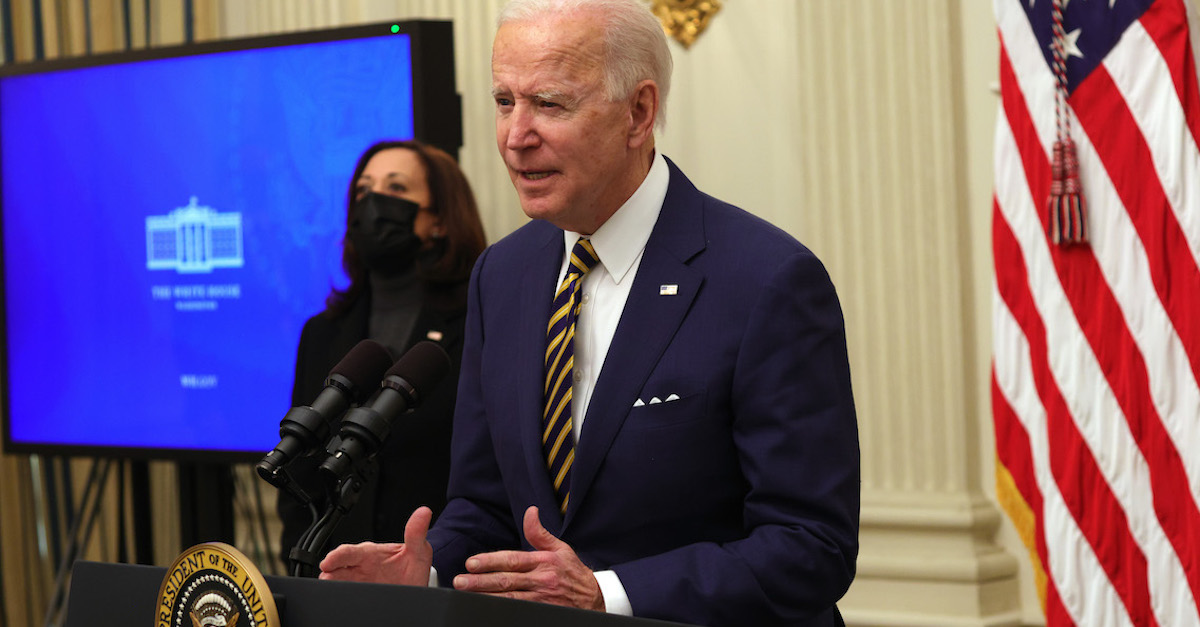
In his first known military action as commander in chief, President Joe Biden on Thursday ordered a series of airstrikes that targeted facilities used by Iranian-backed militia groups on Syria’s Iraqi border. The White House on Friday said the strikes were ordered pursuant to the president’s authority to defend U.S. personnel under Article II of the Constitution and Article 51 of the Charter of the United Nations.
The airstrike targeted Iran-backed militia groups Kait’ib Hezbollah (KH) and Kait’ib Sayyid al-Shuhada (KSS)—killing one militiaman, according to an Iraqi militia official—and was a response to a rocket attack on an airbase in Iraq that is frequently used by the U.S. military. That attack earlier this month resulted in the death of one U.S. military contractor and left nine people wounded.
Article II appoints the president as the commander in chief of the U.S. military, while Article 51 states: “Nothing in the present Charter shall impair the inherent right of individual or collective self-defense if an armed attack occurs against a Member of the United Nations, until the Security Council has taken measures necessary to maintain international peace and security.”
A spokesperson for the National Security Council (NSC) said that the administration’s decision to strike was a proportional response to the actions of the militia groups, in a statement provided to Business Insider.
“The president acted pursuant to inherent self-defense powers enshrined in our Constitution and the UN Charter. We had a rigorous process to include legal review of the strikes conducted,” the spokesperson said. “The targets were chosen to correspond to the recent attacks—the facilities are utilized by KSS and KH—and to deter the risk of additional attacks over the coming weeks. As a matter of international law, the United States acted pursuant to its right of self-defense, as reflected in Article 51 of the UN Charter. The strikes were necessary to address the threat and proportionate to the prior attacks.”
Middle East experts said the military endeavor may have also been meant to establish the administration’s firm stance as it attempts to restart talks about the 2015 international nuclear deal that was abandoned by the Trump administration.
“The strike, the way I see it, was meant to set the tone with Tehran and dent its inflated confidence ahead of negotiations,” Bilal Saab, a former Pentagon official who is currently a senior fellow with the Middle East Institute, told the Washington Post. “You don’t want to enter into potential talks with Iran on any issue with a bruise to your face from the Irbil attacks.”
Critics compared the Biden administration’s use of force in Syria to military strikes ordered by former President Donald Trump. In Jan. 2020, Trump ordered a strike that killed Iranian military leader Qasem Soleimani in Baghdad, claiming that Soleimani presented an “imminent threat” to U.S. troops overseas (though evidence of such a threat was never provided). Iran responded by launching a barrage of missile attacks on a base that housed U.S. troops in Iraq.
The airstrikes in Syria came just weeks after the Trump administration, in its final days, reduced U.S. troop presence to 2,500 in both Iraq and Afghanistan. NATO’s secretary general announced his plan Thursday to increase the number of coalition troops on the so-called “counter-ISIS mission” by 3,500, bringing to total number of those troops to 4,000, according to the Military Times.
[image via Alex Wong/Getty Images]